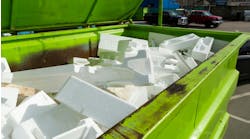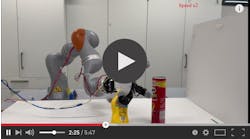| The reduction or elimination of char by Tank-Free systems leads to fewer nozzle plugs and associated downtime for maintenance. |
The shortened exposure of the adhesive to heat in vacuum-based Tank-Free systems also reduces the amount of char formation within the system. Quite simply, less time at temperature results in less adhesive char. With a minimal melted volume, hot adhesive is dispensed quickly and replenished with a fresh supply. The reduction of char leads to less material waste, fewer nozzle plugs, less overall system maintenance, longer fluid seal life and less production line downtime. All of these benefits spell out improved operator conditions as well. With a Tank-Free system, an operator no longer has to hand-fill hot melt pellets and the task of tank-scraping is eliminated. The elimination of the heated tank and reduced operator interaction with the system decreases the chance of burns and other injury. Reduced odor provides an overall better operator experience. Finally, the use of a vacuum feed system keeps the ambient adhesive contained and closed from the outside environment. This dramatically reduces the chances of material contamination. Barring contaminants from the adhesive improves the dispensing process and helps to ensure consistent adhesive application.Intelligent Monitoring
Traditional hot melt tank systems lack intelligence in terms of adhesive usage monitoring. This information is vital to tracking expenses related to the packaging process. With adhesive costs at the forefront of the manufacturing industry’s mind, monitoring solutions are becoming increasingly more important.Emerging hot melt technology offers the detailed adhesive usage information many manufacturers desire. For example, the previously mentioned InvisiPac system from Graco, with its intuitive user interface and USB downloadable operating data, makes it possible to clearly track material usage throughout a given period of time. This allows packaging managers to examine the amount of adhesive used over a single shift, a product run or other set amount of time. The increased tracking information leads to improved record keeping, better understanding of adhesive consumption and needs, and better control over costs in the packaging process. In addition to adhesive consumption, operators now have the ability to track a number of other important factors, including fluctuations in adhesive temperatures, system errors and key event history. This information is invaluable, as running routine reports can pinpoint inconsistencies in the process, optimize the packaging line and identify cost saving opportunities. The process control and reporting data that the customers of many packaging companies are demanding is now available with this monitoring technology. Add in remote monitoring, pioneered by Graco with its LineSite™ Remote Monitoring Solution, and plant managers and operators can have access to all of this operational data and more from anywhere in the world. Manufacturers now have access to hot melt equipment and adhesive data that allows them to make decisions that control costs and improve efficiencies in real time.Increased Adhesive Options
Some packaging companies find themselves transitioning to more expensive, temperature stable adhesives in an attempt to negate some of the drawbacks of hot melt tank equipment. While these adhesives have value to offer in their own right, adhesive choice should not be dictated by the capability of the processing equipment. New Tank-Free hot melt systems have been designed around the broad spectrum of adhesives traditionally used in the packaging market. All packaging grade adhesives are available for use, including metallocene, EVA and others, expanding the options for packaging managers. Customers now have a broad range of adhesive choices with the industry-leading Tank-Free systems.









